

What is LiFi ? High-Speed Internet from the Ceiling Lamp - Fraunhofer HHI. The technology developed by HHI makes it possible to use standard off-the-shelf LED room lights for data transmission.
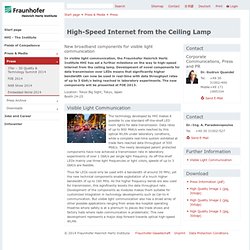
Data rates of up to 800 Mbit/s were reached by this optical WLAN under laboratory conditions, while a complete real-time system exhibited at trade fairs reached data throughput of 500 Mbit/s. The newly developed patent protected components have now achieved a transmission rate in laboratory experiments of over 1 Gbit/s per single light frequency. As off-the-shelf LEDs mainly use three light frequencies or light colors, speeds of up to 3 Gbit/s are feasible. Thus far LEDs could only be used with a bandwidth of around 30 MHz, yet the new technical components enable exploitation of a much higher bandwidth of up to 180 MHz. As the higher frequency bands are also used for transmission, this significantly boosts the data throughput rate. Orthogonal frequency-division multiplexing.
Orthogonal frequency-division multiplexing (OFDM) is a method of encoding digital data on multiple carrier frequencies.

OFDM has developed into a popular scheme for wideband digital communication, whether wireless or over copper wires, used in applications such as digital television and audio broadcasting, DSL Internet access, wireless networks, powerline networks, and 4G mobile communications. Example of applications[edit] The following list is a summary of existing OFDM based standards and products. For further details, see the Usage section at the end of the article.
Cable[edit] Can LEDs help to solve the looming spectrum congestion problem? 11 February 2014 A host of research projects in the established field of visual light communications (VLC) is pushing towards the possibility of using the lighting infrastructure to transmit data at several Gbit/s, with perhaps the most promising approach – dubbed Li-Fi (for light fidelity), a subset of VLC – making waves in several ways.
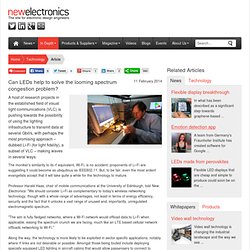
The moniker's similarity to its rf equivalent, Wi-Fi, is no accident: proponents of Li-Fi are suggesting it could become as ubiquitous as IEEE802.11. But, to be fair, even the most ardent evangelists accept that it will take quite a while for the technology to mature. Li-Fi Solves all of Wi-Fi’s Flaws. September 6, 2011 at 8:26 pm pltimme In our world today we hear the buzz words interconnected and wireless communications quite frequently, but as we continue to exchange vast amounts of data between various devices the entire system which we currently use is almost doomed to collapse at some point.

In a recent episode of one of my favorite new age idea/technology websites, TED Talks, Harold Haas revealed an ultra sophisticated way to transmit data. In order to understand the true advantages the new data transmission technology provides, we must first understand the flaws of our current data communication practices. Data is everywhere and part of almost everything we do in today’s world.
Whether we are talking on the cell phone, Skyping a friend, or commenting on Facebook we are exchanging data. With regards to the issues Haas highlights several specific issues exist with each limitations. Las redes LI-FI: una nueva revolución en la telecomunicaciones - hitech. Visible Light Communications. One only needs to read some of the daft comments posted at the foot of online visible light comms articles to understand that there are a large number of misconceptions out there.
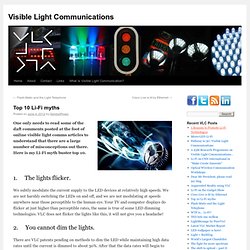
Here is my Li-Fi myth buster top 10. 1. The lights flicker. We subtly modulate the current supply to the LED devices at relatively high speeds. We are not harshly switching the LEDs on and off, and we are not modulating at speeds anywhere near those perceptible to the human eye. 2. There are VLC patents pending on methods to dim the LED while maintaining high data rates until the current is dimmed to about 50%. 3. VLC can be used for transmission in either direction. 4. It is relatively simple to eliminate the vast majority of interference from natural and artificial sources using optical filters (which avoids receiver saturation). 5.
Li-Fi. Li-1st, the first Li-Fi equipment Li-Fi, as coined by Prof.
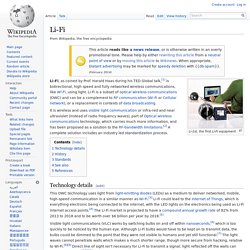
Harald Haas during his TED Global talk,[1] is bidirectional, high speed and fully networked wireless communications, like Wi-Fi, using light. Li-Fi is a subset of optical wireless communications (OWC) and can be a complement to RF communication (Wi-Fi or Cellular network), or a replacement in contexts of data broadcasting. It is wireless and uses visible light communication or infra-red and near ultraviolet (instead of radio frequency waves), part of Optical wireless communications technology, which carries much more information, and has been proposed as a solution to the RF-bandwidth limitations.[2] A complete solution includes an industry led standardization process. Technology details[edit] Visible light communications (VLC) works by switching bulbs on and off within nanoseconds,[6] which is too quickly to be noticed by the human eye.
History[edit] Standards[edit] The standard defines three PHY layers with different rates: LED light bulb 'li-fi' closer, say Chinese scientists. 10 Gbps Li-Fi system shows wireless data transfer in a new light. Light might be the preferred option for transmitting data over long distances via cables, but when it comes to short range wireless, radio waves rule in the form of Wi-Fi and Bluetooth.

Now Mexican company Sisoft, working with researchers from the Autonomous Technological Institute of Mexico (ITAM), has developed a wireless technology that transmits data in visible light emitted from LED lamps, while lighting the room at the same time. Forget WiFi, Connect to the Internet Through Lightbulbs - Technology - GOOD. Whether you’re using wireless internet in a coffee shop, stealing it from the guy next door, or competing for bandwidth at a conference, you’ve probably gotten frustrated at the slow speeds you face when more than one device is tapped into the network.

As more and more people—and their many devices—access wireless internet, clogged airwaves are going to make it increasingly difficult to latch onto a reliable signal. But radio waves are just one part of the spectrum that can carry our data. What if we could use other waves to surf the internet? One German physicist, Harald Haas, has come up with a solution he calls “data through illumination”—taking the fiber out of fiber optics by sending data through an LED lightbulb that varies in intensity faster than the human eye can follow. It’s the same idea behind infrared remote controls, but far more powerful. Professor Harald Haas.
A light-based wireless communication network developed by Edinburgh-based mobile communication specialist pureLiFi could become an essential tool for Government and business in combating terrorism and cyber crime.

The pureLiFi system offers a new and secure way of exchanging information over networks, using light rather than radio waves to communicate between devices. The pureLiFi system offers a new and secure way of exchanging information over networks, using light rather than radio waves to communicate between devices The new light-based communication technology, known as Li-Fi, could provide a substantially increased solution to enhance data security for businesses seeking to improve data protection – from Government and defence organisations through to financial, public sector, pharmaceutical or any ‘high data risk’ industries.
Harald Haas: Wireless data from every light bulb. Translate. LiFi Consortium. PureLiFi™ The Home of Li-Fi » pureLiFi™ LiFi uses light to send and receive data. Sunpartner Technologies » Smartphones & Tablettes. Exclu : le 1er smart phone compatible Li-Fi. Par Bernard Fontaine, France Télévisions Editions Numériques.
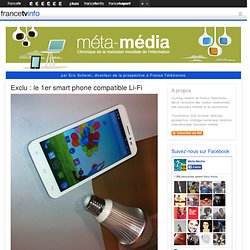
Visible Light Communication devices ready for commercialization. Outstanding Technology has developed two commercial products using visible light communication technology, using LED lights to transmit data. These are a location service for smartphones, called the Commulight System, and a visible light transceiver, the TR01. The Commulight System consists of a receiver that plugs into a smartphone or tablet, and LED lights with a built-in transmitter.
The receiving device obtains IDs emitted by the LED lights, enabling it to download content relevant to the user's location. The receiver is available in two types, one that connects via USB, and one that connects via the headphone jack. "The most obvious application for this system is guiding visitors in galleries and museums. "Positioning services using indoor GPS and wireless communication already exist. Using light from LEDs instead of radio signals also makes it possible to communicate in tunnels and factories, where radio reception can be difficult. Profile on TED.com. 'Li-fi' via LED light bulb data speed breakthrough. 28 October 2013Last updated at 09:10 ET By Matthew Wall Technology reporter, BBC News. Project Li-Fi. Eric Packman, August 10, 2013 #hwdesigncontest #buildsomething My project was an attempt to replace my old nemesis, wifi, with an alternative that's safe, secure, fast and not prohibited by the CRTC.
It occurred to me that if, for example, an LED driving multimode fiber optics can attain multi-gigabit speeds, why can't LED lighting in the house also communicate information, at least fast enough for home tasks? Turns out, it can. Can Li-Fi speed up the web? Li-Fi to Replace Wi-Fi,Chinese Students New Research. Luciom presents at CES, 2 different applications: Indoor positioning and geo-marketing et High data rate video transfer.